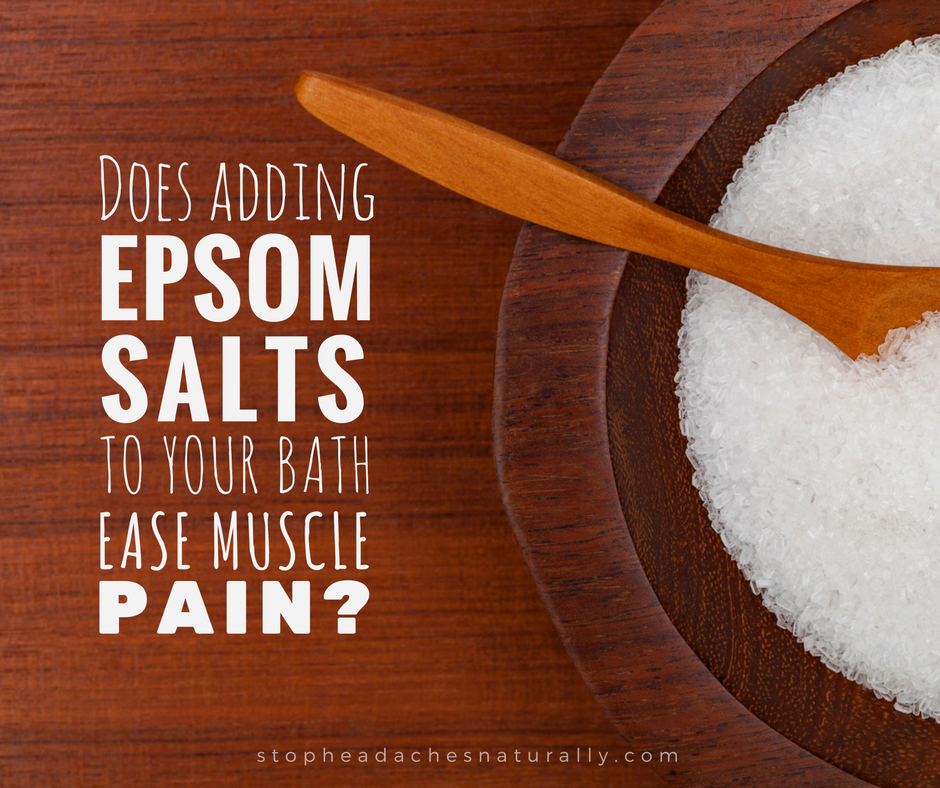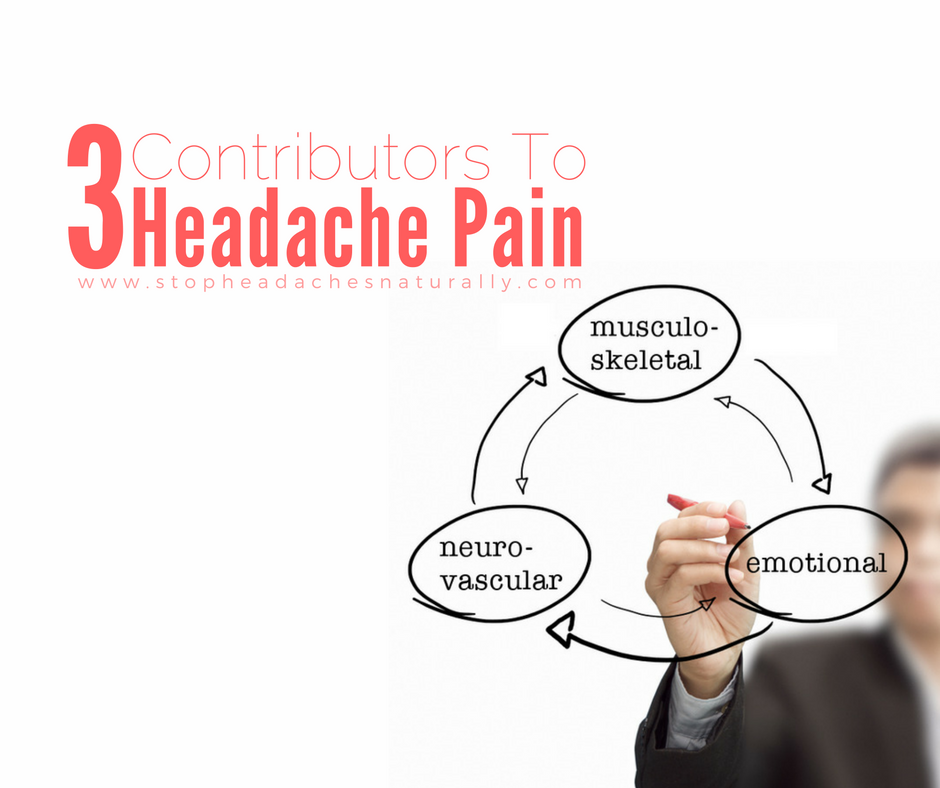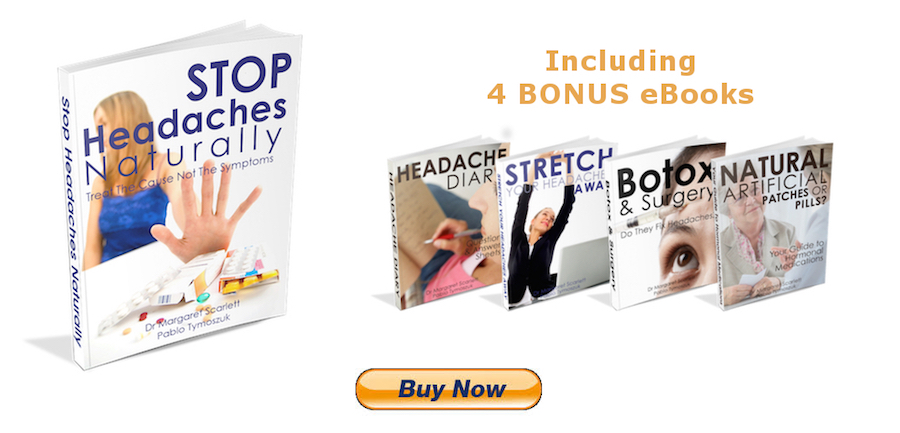Does Adding Epsom Salts To Your Bath Ease Muscle Pain?

Adding Epsom salts can make your bath more effective. This is an old home remedy for easing muscle pain which is still widely used today. It is not just an old wives’ tale – there are good reasons for thinking it will help your muscles and your headaches.
Epsom salts act as a source of magnesium ions. These play an essential role in body chemistry, including the maintenance of normal functioning of nerves and muscles.
"Epsom salts act as a source of magnesium ions… including the maintenance of normal functioning of nerves and muscles."
Many headache sufferers have lower than normal levels of magnesium ions in their blood and brain [5,6,7,8] and intravenous magnesium will often quickly relieve a headache attack.[8,9]
Magnesium ions can also enter the bloodstream by absorption across the skin [10,11]. A small study showed that soaking in an Epsom salt bath for 12 minutes two times a week should be sufficient to restore normal levels.[11] The effects on headaches have not been studied but it seems well worth trying.
"Many headache sufferers have lower than normal levels of magnesium."
You will need about 2 cups of Epsom salts in a standard sized bath tub.
If you suffer from migraines, you may have noticed that your hands and feet tend that tend to get colder before and during an attack.
For many people this is a reliable early warning sign.
A warm bath taken at this stage will help prevent the attack from progressing further by drawing blood away from your head towards your extremities.
This is an excerpt from the ebook Stop Headaches Naturally - Chapter 11.15 - Heat, Cold and other Therapies
References:
[5] P Sarchielli, G Coata, C Firenze, P Morucci, G Abbritti and V Gallai (1992). “Serum and salivary magnesium levels in migraine and tension-type headache. Results in a group of adult patients.” Cephalalgia 12(1): 21-27.
[6] BM Altura and BT Altura (1996). “Role of magnesium in patho-physiological processes and the clinical utility of magnesium ion selective electrodes.” Scand J Clin Lab Invest Suppl 224: 211-234.
[7] A Mauskop, BT Altura, RQ Cracco and BM Altura (1993). “Deficiency in serum ionized magnesium but not total magnesium in patients with migraines. Possible role of ICa2+/IMg2+ ratio.” Headache 33(3): 135-138.
[8] A Mauskop and BM Altura (1998). “Role of magnesium in the pathogenesis and treatment of migraines.” Clin Neurosci 5(1): 24-27.
[9] A Mauskop, BT Altura, RQ Cracco and BM Altura (1996). “Intravenous magnesium sulfate rapidly alleviates headaches of various types.” Headache 36(3): 154-160.
[10] H Laudańska, A Lemancewicz, M Kretowska, T Reduta and T Laudański (2002). “Permeability of human skin to selected anions and cations--in vitro studies.” Commun Mol Pathol Pharmacol 112(1-4): 16-26.
[11] Dr RH Waring (2009). “Report on Absorption of magnesium sulfate (Epsom salts) across the skin.”
Can A Happy Spouse Be Good For Your Health?

Happy hubby, happy wifey…
A recent study published in the Health Psychology Journal suggests that having a happy spouse is good for your health. Nearly 2,000 couples aged between 50 and 94 were asked about their happiness, health and exercise levels over the course of six years and these are some of the findings:
- Happy spouses are more likely to provide strong social support, such as caretaking
- Happy spouses encourage their partners to adapt healthy habits - regular exercise, eating well and adequate sleep
- Having a happy partner may enhance health and make life easier
So as the saying goes, “Happy wife, happy life” but now we can add, “Happy hubby, happy wifey.”
3 Reasons You Have Headache Pain

When we started writing this book our focus was on headaches provoked by musculoskeletal problems, and especially by muscular trigger points. However many other factors unrelated to musculoskeletal problems are known to provoke headache attacks, including tiredness, dehydration, certain foods, changes in female hormone levels and flashing lights, to name but a few.
We wanted this book to be useful to as wide range of headache sufferers as possible, so we decided to increase its scope to cover such cases. However we then faced the problem of how to unify all of this information.
From our research we came up with a simple model based on the nature of headache pain. In this model, headache pain arises from a combination of 3 separate contributions:
1. A musculoskeletal contribution – due to problems with muscles and joints
2. A neurovascular contribution – due to changes in nerve activity and blood flow in parts of the brain
3. An emotional stress contribution – this acts like a pain volume control
Reducing any one of these contributions lessens the pain you feel. It may even lessen it sufficiently to prevent a headache from occurring in the first place.
"Reducing any one of these contributions lessens the pain you feel."
There are a number of natural methods available to reduce each of these contributions. For example, the contribution to headache pain from musculoskeletal problems can be readily treated by manual therapy, together with correction of posture, stretching and strengthening of postural muscles.
Emotional stress can be treated by a variety of techniques including relaxation, biofeedback and altering negative thought patterns. The neurovascular contribution can be reduced by making changes to your lifestyle, environment and diet and by reducing emotional stress.
These techniques and more are covered in this book.
This is an excerpt from the ebook Stop Headaches Naturally - Introduction: A Model For Headache Pain





